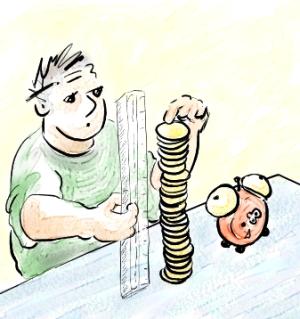
Maths in a minute: What's average?
Most people have more than the average number of ears. This might seem odd, but it's true. The vast majority of people have two ears, but the few who have only one or none bring the average down to less than two. It's easy to illustrate this by imagining there are only five people in the world with one of them having only one ear. The average number of ears is
$$\frac{2+2+2+2+1}{5} = \frac{9}{5} = 1.8.$$
What's the best way of measuring a population's income?
The average (technically called the arithmetic mean) is computed by adding up the number of ears of all people in the world and then dividing by the total number of people. The example illustrates that the average isn't always the best measure to use when you want to make a wholesale statement about something. For example, a few super-high earners can drive up the average income in a population, giving the impression that people on the whole are much better off than they actually are.
But luckily, there are other measures you can use that might be more appropriate. One is the median. You compute it by listing all the numbers in question (ears, income, etc) in order and picking the middle one. For example, if there are five people earning £1000, £1000, £3000, £3500 and £4000 a month, then the median is £3000. It tells you that roughly half the people earn less than that and the other half more (if there were an even number of people, the median would be the number lying exactly half-way between the middle two — in other words, it would be the arithmetic mean of the middle two).
Alternatively, you could compute the mode. That's the number that appears most frequently in your list. In the example above the mode is £1000, telling you that most people in your list earn that amount. Or you might go for the midrange: add the smallest and the largest number and divide by two. In our example that gives (£1000+£4000)/2 = £2500. (Statisticians don't use the midrange very often though, partly because, like the arithmetic mean, it is easily skewed by outliers.)
So, next time you hear an average quoted in the news, keep in mind that it may be misleading.
You can find out more in the articles All about averages and Damn lies, or try our puzzle Meddling with averages.
Comments
Anonymous
The gas laws as derived by Boyle and Charles tell us about the average properties of the gas. The nature of each molecule is not the same and to use these properties to determine the average properties is not the right way to go in analysis. However when it comes to the subject of macroeconomics the vast majority of its protagonists don't seem to appreciate this. Consequently the separate subject of micro- and macro- economics become confused. Since we are one of the "molecules" ourselves it is very easy to forget that we need to view the subject of macroeconomics objectively and from afar.
This writer has been researching macroeconomics for a long time and he can clearly obtain sufficient logic about it so as to determine laws that are independent of the micro- structures we feel around us in everyday use. In fact by taking aggregate properties of idealized functional entities within our social system as a whole, it is possible to learn much more about how it works.
math.nights
To Arabic: https://goo.gl/SFVA75